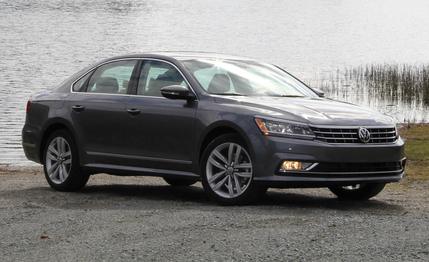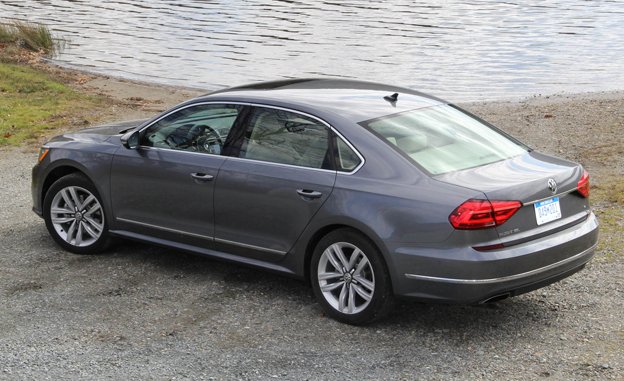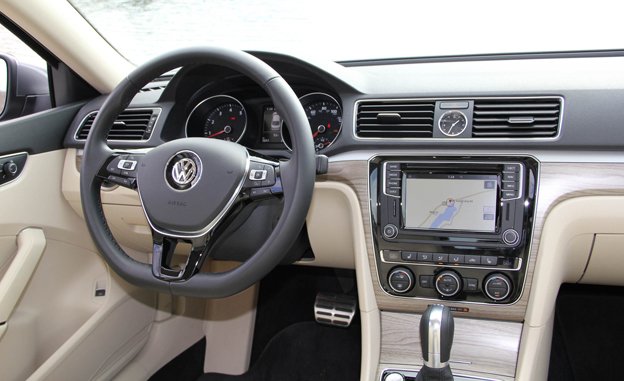 First Drive Review
First Drive Review
In the wake of the TDI emissions scandal—or are we still in the build-up phase?—Volkswagen is in need of some good news. The launch of a new model can provide just that, and the 2016 Passat is sufficiently different from the 2012–15 models to justify a modicum of enthusiasm.
It’s true that the U.S.-built Passat has failed to give competitors like the Honda Accord and the Toyota Camry a serious headache in the way that VW had hoped. But the company has taken in plenty of customer feedback to make the 2016 model a better and more attractive car. On the technical side, there are vastly improved connectivity features plus a new electronics and infotainment architecture that allows for a full range of driver-assistance systems (most notably forward-collision, blind-spot, and lane-departure warning as well as lane assist). The front end receives structural upgrades designed to address the IIHS's rigorous and ambitious new crash tests; they add between 50 and 100 pounds to the Passat's weight.

The styling has been altered, too; VW admits that "existing customers were happy with it, but it wasn't enough to draw in new ones." From the A-pillar forward, the entire front end is redesigned, but one might argue that the changes could have been bolder. More than anything else, the new model adds some glitz and complexity; the most notable feature is a thick, silver lip that spans the entire width of the headlights and grille on models that are fitted with LED headlights. Cars with the standard halogens instead get a gloss-black strip.
There are several new wheel designs for the Passat, and the taillights and trunklid have been redesigned for a crisper and more modern look. The best-looking Passat is the R-Line; it comes with sportier front and rear fascias and 19-inch wheels. The R-Line, curiously, is not a package but a trim level; it’s based on the entry-level S model. If you want any of the technology features of the SE, the SEL, or the SEL Premium, you’re stuck with the standard look.
Inside, the relatively subtle changes include new instruments, new materials, a horizontal crease atop the dashboard, and decor that looks far more upscale than that of the previous Passat’s. Beyond that, there wasn't much to fix. The Passat's cabin is roomy and airy, and the seats are pleasantly firm. This is a great long-distance cruiser.
That's true not just because of the comfy cabin. The chassis is still one of the best in its class. It absorbs uneven and challenging surfaces with aplomb, but it's also a lot of fun. The Passat is agile and composed, with precise steering that's definitely on the lighter side. This family sedan doesn't mind playing when nobody is watching, and the oversight of the various driver-assistance systems that come with the top-end SEL Premium model isn’t very aggressive. For example, the lane-assistance system keeps the Passat in line by corrections of the steering wheel, but it kicks in relatively late and is too laid-back to be considered hands-free.

The Passat's sporting ambitions are curtailed by the entry-level engine, a turbocharged 1.8-liter TSI four-cylinder that cranks out a modest 170 horsepower at 6200 rpm and a somewhat more respectable 184 lb-ft of torque at just 1500 rpm. Mated to a quick-shifting six-speed automatic, it propels the Passat to 60 mph in 8.1 seconds, according to VW; we recorded a time of 7.5 seconds with this powertrain in our test of a 2014 model. This powertrain doesn't transform the sedan into a racer, but at least it is smooth and responsive, and it’s more fun than the naturally aspirated engines offered in most of its competitors. Its EPA city/highway ratings of 25/38 mpg are respectable if not class-leading.
Fuel economy is less stellar on the top-of-the-line model, with its 3.6-liter VR6, but that engine turns the Passat into a real performance sedan. Rated at a robust 280 horsepower and 258 lb-ft of torque, the naturally aspirated, narrow-angle V-6 is ultra-refined and delivers its power in a beautifully linear fashion. Moreover, it’s coupled to VW's fantastic six-speed dual-clutch automatic transmission. VW says the sprint to 60 mph takes 6.5 seconds—it took 6.3 in our test of this powertrain when the car was launched—and top speed is governed at 130 mph.
Conspicuously absent from the lineup is the 150-hp 2.0-liter TDI, which has not yet been EPA-certified for the 2016 model year. When and if it does come to market, it will be the only Passat available with a six-speed manual transmission; the TDI also will offer a six-speed automatic.
A more pointed attack on the Camry, Accord, et al, won’t come until the all-new, MQB-platform-based Passat arrives for its 2019 debut. Until then, however, the upgraded and updated model deserves a close look by anyone shopping in the segment. As for the TDI, VW executives say they want to offer it again, but it’s hard to imagine that buyers will go near it—at least beyond the most ardent diesel loyalists, if those still exist.